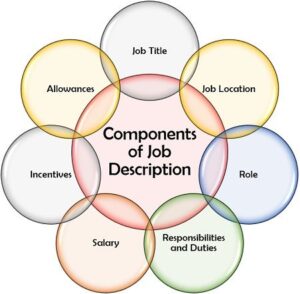(Reading Time: 5 minutes)
Knowing the difference is key to attracting a diverse pool of candidates for your open positions
Have you ever encountered a nine-page job posting?
I have, and when I do it tells me two things—one, the company doesn’t know the difference between a job post and a job description. And two, the poster has forgotten who their audience is: job seekers.
That’s why I thought it was time to review the difference between the two.
First, let’s talk about the job description.
A Job Description is for Somebody Who Already Has the Job
A job description should start with the title, then list the duties and responsibilities of the role, who the person interacts with,  who they report to and who reports to them. It should also include any limits of authority (i.e., what they can do without seeking further approval), and any other pertinent details relating to the role.
who they report to and who reports to them. It should also include any limits of authority (i.e., what they can do without seeking further approval), and any other pertinent details relating to the role.
In an ideal world, a company and employee would review the job description annually to make sure it’s still in line with the role. However, I suspect that only ever happens if there is a change in the role, there’s a change in the salary grade that necessitates it, or a wholesale reorganization of the company’s structure overall.
The Purpose of a Job Posting is to Attract Somebody to the Job
A job posting is really a marketing document.
You want the job post to show why the role is an interesting opportunity for anyone who would consider it and highlight the most appealing aspects of the position. Ideally, that is the inherent nature of the job itself that certain individuals will find irresistible but maybe it’s the salary or broader compensation package, the location, opportunities for advancement, or even the reputation of the company with the role to fill.
You want to keep it brief—no more than two pages max—and written with the job seeker in mind. You should include:
- title

- location, including whether it’s hybrid (work from home opportunity) or all in-office
- the company and scope of the role, including aspects of the job that a suitable candidate may find fulfilling
- the salary range and compensation components
- opportunities for advancements
- experience or educational requirements
- travel requirements (average % of nights per month not at home).
Title
Title can be tricky.
First of all, you want to avoid making it too technical. For example, you might be hiring for a paper machine supervisor, but that doesn’t mean anything to the outside world. We might say manufacturing supervisor instead. We may well be looking for someone with a paper background, but if we say paper machine supervisor, nobody is going to apply, because it’s very narrow. We may be able to take someone from the auto industry, for example, put them in the paper industry and it’s fine.
Sometimes there’s a conflict between what we think would be good in the market and what a company’s own policies are. Take a role like human resources or finance, which can have many levels and degrees of titles (Junior, Intermediate, Senior, Manager, Director, Vice President). Some people are extremely title-sensitive and will avoid applying for a job that has a title that they believe is beneath their level, regardless of any other aspect of the position.
Companies can be caught in a conflict between what title will work best to attract the right candidate and maintaining internal consistency, either within the particular company location or between similar roles in other locations.
Location
Of course, the other thing that people are interested in is location. If you expect an employee to be in the office, you should say where the office is, and how many days an employee is required to be
 For many candidates these days, location is critical. They want to know how much commute time they’ll need to account for, and what that commute would look like.
For many candidates these days, location is critical. They want to know how much commute time they’ll need to account for, and what that commute would look like.
People will often take a pay cut to be close to home. It’s extremely attractive to people living in the suburbs to see a job in the suburbs. Now they are 10 minutes from home, whereas before they were commuting 45 minutes to downtown or across the city somewhere.
So, for an opportunity that pays less but is closer to home, many people will live with a slightly lower salary that can be offset by a shorter commute.
Selling the company and scope of role
Don’t forget that the company itself may be an attraction.
Some people will have a great deal of pride in sharing their business card with friends and family, knowing it has a recognizable company name with a good corporate reputation. That can mean stability, upward mobility, and solid benefits.
With an established company, a new hire is going into a situation where a lot of the policies and procedures are already set out, so it’s easier to slip into that role. It’s all laid out, there’s a training program, they’ll be able to fit in with the company very quickly, and know what their duties are.
Others are attracted by the excitement and fast pace of a new situation, like a start-up. They’ll be energized by the opportunity to create something new and set an example for others to follow. There’s unlikely to be any training or existing policies and procedures; in fact, the company might well be depending on the new hire to create those policies and procedures.
So, the job posting needs to include information about the company and the role that will help a potential applicant understand that. Be sure to include how long the company has been in business, and demonstrate the stability (if appropriate) it has, and make sure to include a website link. Be clear about whether this is a new venture, an established role at an established company, or a new role at an established company.
Salary and compensation components
I acknowledge that companies don’t always want to list a target salary because they don’t want their own employees to see it or be tied to a number during the hiring process. However, it’s better if we can at least quote the salary range in the job posting.
I also recommend that you indicate other items of compensation, such as whether there is a benefit plan, form of pension or RRSP plan, vacation, and vehicle or travel allowance.
Opportunities for advancement
Going beyond compensation, the next thing a person would think about is the career opportunity. Is this a fast-growing company? Is there room to move up in the company, and will there be opportunities to grow and to learn?
For example, will there be opportunities to learn a new skill. Obviously, they are going to be hired for their current skill, experience, and perspective, but perhaps the job posting can indicate where there will be chances to learn additional things and gain more experience on top of what they already have.
Education and experience
 This seems obvious but be sure to include the education and experience necessary for the role, and any professional designations that are required, if appropriate. I find that sometimes applicants fib about this to get through the screening process, but it is a helpful guide. Done properly, you will catch any game players in the reference checking process.
This seems obvious but be sure to include the education and experience necessary for the role, and any professional designations that are required, if appropriate. I find that sometimes applicants fib about this to get through the screening process, but it is a helpful guide. Done properly, you will catch any game players in the reference checking process.
Travel requirements, if any
Don’t forget to include how much overnight travel that might be involved in the role. It should be expressed as an estimated percentage of nights in a month that they might expect to be away versus at home. So, if it’s 10%, they might be away on average, say 2 or 3 nights a month, that’s the way to think about a travel requirement. Unless someone is afraid of flying, traveling to another city for a meeting and still being back and home for dinner is not really “travel.”
Of course, at the end of the day, the most important thing with any posting is to make sure you’re not unintentionally limiting the pool of candidates. As I have written elsewhere, the greater quantity of qualified candidates you have, the better chance of success.
Larry Smith is the founder and president of Kathbern Management, an executive search firm based in Toronto. Kathbern helps companies find the executives and senior managers who not only have the experience and credentials to fulfill their responsibilities, but also have the emotional and “fit” requirements that will enable them to be successful in a particular environment. Kathbern simplifies the process and, through deep research, brings more and better candidates forward than would ever be possible through a do-it-yourself passive advertising campaign.
Learn more at www.kathbern.com, or contact us today for a free consultation about your key person search. Follow us on LinkedIn, Facebook, and Twitter.

